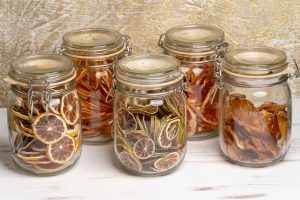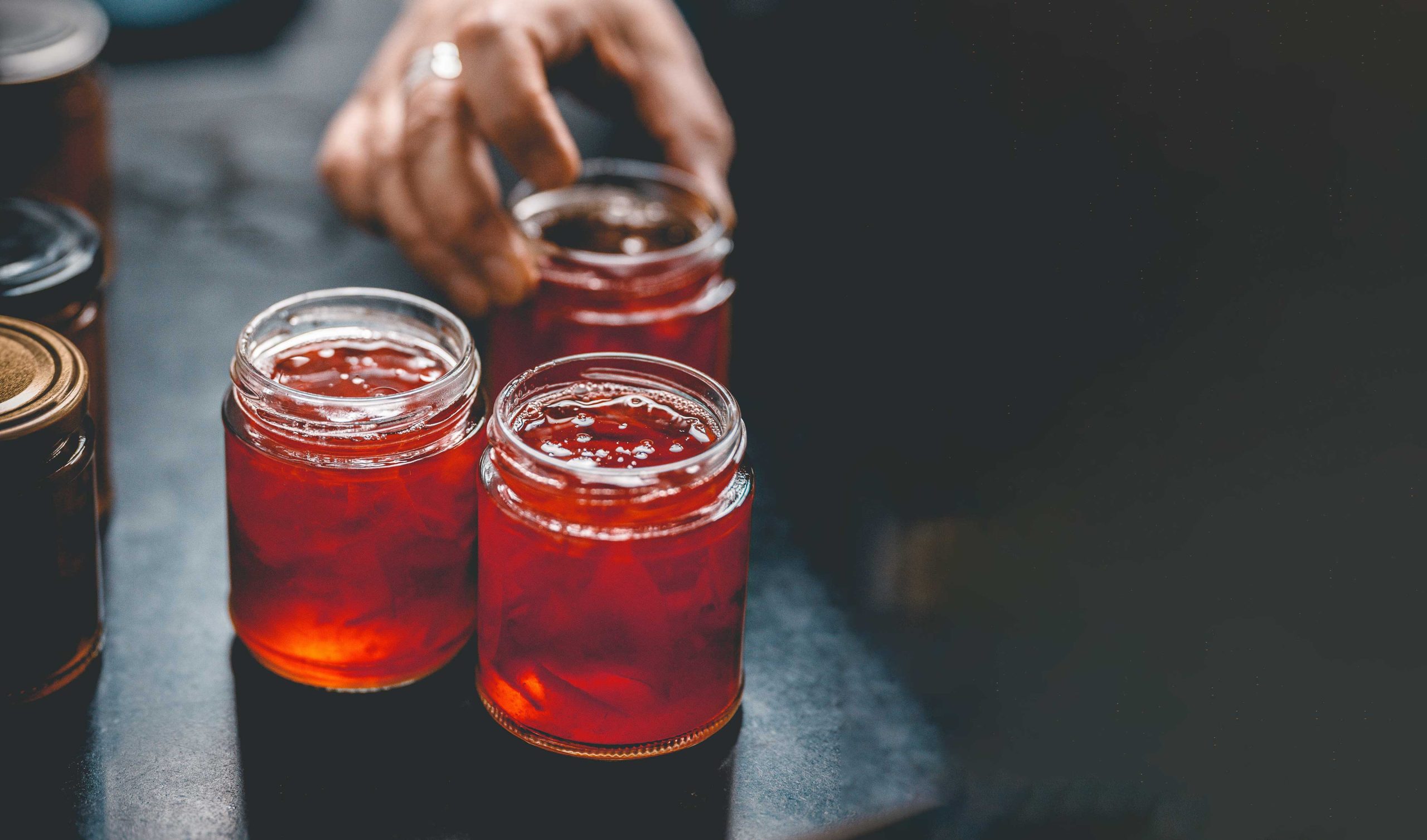After months of sweet, juicy deliciousness, the Australian citrus growing season is beginning to wind down. We started with a blushing burst of Cara Cara, then segued into magnificent Mandarins and bodacious Blood Oranges, with a side of Tangelos and Lemon Squeeze for good measure. Along the journey, we also introduced our monstrous Mega Mandie Dekopon oranges to our delectable Dracula family.
As Dracula and his ghoulish crew head back to the crypt for a well-earned extended break, you may find a rising sense of dread and panic overcoming you. How will you get through the off-season without your Aussie citrus fix?
Well, the good news is, you don’t have to fret. While nothing compares to the superb flavour of fresh fruit, you may be surprised to learn how simple and satisfying preserving citrus fruit can be.
In a previous post, we shared a range of amazing things you can do with orange peel. In this piece, we’ll help you boost your gastronomic game to titillate your tastebuds all year round with a spectacular variety of flavours and textures. You’ll never find yourself pining for Dracula Citrus™ again with this lineup of mouthwateringly creative ideas:
Blood Orange Marmalade
This incredible marmalade uses every part of the orange to make toast into a feast for the senses. The technique is not the simplest but produces superior flavour and thickness. The secret is pectin, which is commonly used as a gelling agent. Citrus pith is loaded with pectin (you can even use citrus peel to make your own pectin to use in other jams and preserves!), so a little bit of extra love and care will ensure a delicious marmalade that looks, feels and tastes uber-professional.
What You Need:
• 4 Blood Oranges
• 2 Lemons
• 1 Litre of Water
• 3 Cups of Sugar
• 1 Star Anise
• 2-3 Cloves
• 1 Cinnamon stick
This is How We Do It:
- Using a vegetable peeler, remove the outer zest peel of the oranges and lemons, taking care to remove as little of the spongy, white pith as possible.
- Slice the remaining fruit, remove the pith and seed and set them aside.
- Wrap the seeds and pith in cheesecloth with the star anise, cloves and cinnamon stick.
- Pulse the orange and lemon flesh in a food processor until it reduces to smallish bits. Don’t go overboard, as the fruit will break down further in the cooking process and may turn out too thin.
- Combine the processed fruit, peel, cheesecloth portion and water in a large pot and leave unrefrigerated overnight. This will help draw the pectin out of the pith and ensure an amazing consistency.
- The next day, bring the contents of the pot to boil and cook for 20-30 minutes until the peel is soft and tender. Remove from the heat and discard the cheesecloth package and all its contents.
- You should now have about 3 cups of mixture. Add ¾ – 1 cup of sugar per cup of mixture, depending on how sweet your tooth is. Yes, this will look like a TON of sugar. However, your proto-marmalade will be highly acidic at this point, and you’ll need that sugar to balance the flavour out.
- Bring to a boil, stirring continuously until the sugar completely dissolves.
- Continue stirring until the mixture reaches gelling point.
Pro Tip:
To test whether the mixture has reached gelling point, spoon a tablespoon of mixture onto a cold plate and put it in the freezer for a few minutes. Remove from the freezer and gently push the surface. If the marmalade wrinkles up, you’re good to go! Once the mixture is the right consistency, remove it from the heat and ladle it into clean, prepared jars. Make sure to leave about half a centimetre of airspace between the marmalade and the lip of the jar. Close the jar firmly with an airtight lid and store in the fridge, or freeze for longer shelf life.
Preserved Lavender Lemons

Preserved lemons are an incredibly simple yet delicious way to enjoy lemons any time of year without having to pay exorbitant prices for imported fruit when they’re out of season. Fermented lemons pair beautifully with most Middle-Eastern or South Asian dishes, adding a bright dash of citrusy bite.
They also add vitality to more standard Western fare. By adding a little preserved lemon when roasting chicken, cooking rice, steaming vegetables or baking fish, you can make a great dish extraordinary.
This recipe puts a delicate spin on the traditional preserved lemon by adding a gentle hint of lavender into the mix. The sweet aroma of the lavender is a surprisingly perfect counterpoint to the sour, salty flavours and creates a mellower, more complex flavour profile.
What You Need:
• 4 Lemons
• ½ – ⅔ Cup of Salt
• 5-6 Tablespoons of Dried Lavender Buds
• 1L jar with tight filling lid
This is How We Do It:
- Prepare the lavender buds by drying them in the sun or hanging them. If you’re short on time (or patience), preheat your oven to the lowest setting, spread the buds on an ungreased baking tray and bake them until they’re dried. Make sure to check them every 5-10 minutes to ensure they don’t burn.
- Thoroughly wash and dry the jar, then sprinkle approximately 2 teaspoons of salt over the bottom.
- Add about 2 tablespoons of lavender buds to the salt and shake gently to ensure they are mixed evenly.
- Remove both ends of the lemons, then cut into quarters, taking care not to slice all the way through, leaving the sections connected at the bottom. This has the added bonus of making the lemons look a bit like a flower which is quite visually appealing.
- Sprinkle 1 teaspoon of salt throughout the inside of each lemon.
- Place your first lemon cut-side down into the jar. Press down so that much of the juice is extracted from the fruit.
- If there is still room, repeat with another lemon until the bottom of the jar is covered.
- Top the first layer with another teaspoon of salt and a tablespoon of lavender bud.
- Repeat the process, ensuring to squeeze a bit of juice from each lemon until the jar is full and the lemons are well covered with liquid. If you want, use a fermentation weight to ensure the lemons are compressed.
- Add a final layer of salt and lavender to the topmost layer
- Affix the lid on the jar tightly, and set it aside on your counter for at least 1 week, or preferably 2. You can experiment with leaving it longer if you like. For best results, give the jar a gentle shake every few days to blend the flavours.
- When the lemons are fermented to your preferred level, store them in the refrigerator for the best shelf life.
Once you have the process down, you can experiment with replacing the lavender with other herbs and spices such as star anise, cloves (these are amazing!), allspice, ginger slices or anything else that takes your fancy. Enjoy!
Dehydrated Citrus Slices

There is something so delightfully earthy about the look and aroma of dried citrus slices. As the fructose caramelises with exposure to eat, the colours of the fruit darken and take on rich, elemental tones that add a striking visual touch to any dish, beverage or even decoration.
The uses are essentially limited only by your imagination. To get the creative juices flowing, here are a few suggestions:
- Layer atop cakes or pastries, or muffins, such as our mind-blowing Cara Cara Orange Layer Cake
- Add a slice to the rim of your favourite fruity cocktail
- Steep in hot water or add to tea for a refreshing, healthy infusion
- Add colour to a cheese board
- Chop into fine chunks and sprinkle a dash over granola for a citrusy twist.
- Add to wine for a superb Sangria-like kick.
Preparing these little beauties is incredibly easy. If you have a dehydrator, you can simply use it in the same way you would for any other fruit. For extra credit, you can also use an air fryer, although this dries the fruit far more quickly (usually about 40 minutes), so you’ll need to be on your toes to ensure they don’t burn.
However, for the best aesthetic effect, we prefer the oven. The higher heat delivers irresistibly gorgeous dark colour tones that add an extra sensory dimension to your dish. Conversely, the gentler heat of the dehydrator produces a lighter colour.
This is How We Do It:
- Choose the freshest, firmest citrus fruits, as they are easier to slice. Try to dehydrate them as soon as possible after purchase.
- Use a mandolin or sharp knife to cut the fruit into ¼ – ½ cm slices crossways.
- Arrange the slices in a single layer on a wire rack, set inside a baking tray lined with baking paper, making sure they don’t overlap.
- Bake at 90oC for 3-4 hours. After 1-2 hours, check periodically to ensure the slices are not burning or getting too brown and hard.
- Store in an airtight container in a cool location, away from direct sunlight. The slices can last for years if stored correctly.
Voila! It’s genuinely that easy!
We guarantee that you’re going to love this addition to your culinary repertoire. When you’re confident with the process, you can start mixing things up a little bit to create new and exciting flavours and textures:
• While the pith will lose much of its bitterness during the dehydration process, you can remove it and dehydrate the fruit sans-peel for a more mellow taste.
• Sprinkle the slices with raw sugar before putting them in the oven to create a candied delight.
• You can also experiment with your favourite spices to create a range of complex flavours. As with the preserved lemons above, cloves, star anise, cloves, ginger, and allspice are perfect foils for any citrus fruit. However, don’t be afraid to let your imagination run wild to discover new taste sensations!
With these 3 incredible techniques, you will not only keep the citrus love flowing well after the harvesters have been locked up for the off-season – you will also amaze your friends and family with vibrant elements that add colour and flavour to an extraordinary range of dishes, desserts and drinks.
Best of all, preserving citrus fruit is fun and exciting, allowing you to watch chemistry in action in the most delicious way imaginable and tide you over until the Aussie citrus season rolls around again next year!








